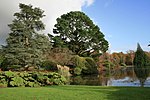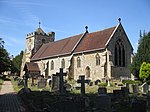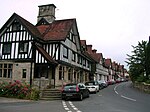Sussex (), from the Old English Sūþsēaxe (lit. 'South Saxons'), is a historic county in South East England that was formerly an independent medieval Anglo-Saxon kingdom. It is bounded to the west by Hampshire, north by Surrey, northeast by Kent, south by the English Channel, and divided for many purposes into the ceremonial counties of West Sussex and East Sussex.
Brighton and Hove, though part of East Sussex, was made a unitary authority in 1997, and as such, is administered independently of the rest of East Sussex. Brighton and Hove was granted city status in 2000. Until then, Chichester was Sussex's only city. The Brighton and Hove built-up area is the 15th largest conurbation in the UK and Brighton and Hove is the most populous city or town in Sussex. Crawley, Worthing and Eastbourne are major towns, each with a population over 100,000. Sussex has three main geographic sub-regions, each oriented approximately east to west. In the southwest is the fertile and densely populated coastal plain. North of this are the rolling chalk hills of the South Downs, beyond which is the well-wooded Sussex Weald.
Sussex was home to some of Europe's earliest known hominids (Homo heidelbergensis), whose remains at Boxgrove have been dated to 500,000 years ago. Sussex played a key role in the Roman conquest of Britain, with some of the earliest significant signs of a Roman presence in Britain. Local chieftains allied with Rome, resulting in Cogidubnus being given a client kingdom centred on Chichester. The kingdom of Sussex was founded in the aftermath of the Roman withdrawal from Britain. According to legend, it was founded by Ælle, King of Sussex, in AD 477. Around 827, it was annexed by the kingdom of Wessex and subsequently became a county of England. Sussex played a key role in the Norman conquest of England when in 1066, William, Duke of Normandy, landed at Pevensey and fought the decisive Battle of Hastings.
In 1974, the Lord-Lieutenant of Sussex was replaced with one each for East and West Sussex, which became 2 separate ceremonial counties. Sussex continues to be recognised as a geographical territory and cultural region. It has had a single police force since 1968 and its name is in common use in the media. In 2007, Sussex Day was created to celebrate the county's rich culture and history and in 2011 the flag of Sussex was recognised by the Flag Institute. In 2013, Secretary of State for Communities and Local Government Eric Pickles formally recognised and acknowledged the continued existence of England's 39 historic counties, including Sussex.












